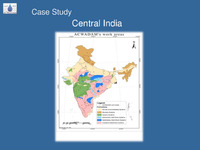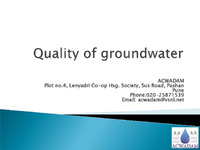Items
Tag
water quality
-
 Case Study Central India The project in Central India, led by the Advanced Center for Water Resources Development and Management and Samaj Pragati Sahayog, focuses on sustainable groundwater management in Bagli Tehsil, where reliance on groundwater is increasing but data for effective planning is lacking. It involves gathering hydrogeological data and community participation to create a comprehensive understanding of groundwater resources. This includes monitoring water levels, quality, and recharge rates across various aquifers, developing protocols for responsible water use, and implementing measures to protect recharge areas and regulate abstraction. The goal is to ensure equitable management of groundwater resources amid rising demand.
Case Study Central India The project in Central India, led by the Advanced Center for Water Resources Development and Management and Samaj Pragati Sahayog, focuses on sustainable groundwater management in Bagli Tehsil, where reliance on groundwater is increasing but data for effective planning is lacking. It involves gathering hydrogeological data and community participation to create a comprehensive understanding of groundwater resources. This includes monitoring water levels, quality, and recharge rates across various aquifers, developing protocols for responsible water use, and implementing measures to protect recharge areas and regulate abstraction. The goal is to ensure equitable management of groundwater resources amid rising demand. -
 BOHAL SPRING CASE STUDY The Bohal Spring, situated in Bohal Village near Palampur, has experienced a decline in water discharge and quality over the past decade due to human activities. To address these issues, a study aims to create a hydrogeological map, identify recharge zones, and develop a spring management plan focused on protection and conservation. Key recommendations include community-led protection initiatives, catchment treatment measures, and monitoring of rainfall and water quality. A formal agreement between the Palampur Municipal Committee and the local Village Forest Development Society will facilitate sustainable management, including financial support and restrictions on resource use to enhance the spring's viability.
BOHAL SPRING CASE STUDY The Bohal Spring, situated in Bohal Village near Palampur, has experienced a decline in water discharge and quality over the past decade due to human activities. To address these issues, a study aims to create a hydrogeological map, identify recharge zones, and develop a spring management plan focused on protection and conservation. Key recommendations include community-led protection initiatives, catchment treatment measures, and monitoring of rainfall and water quality. A formal agreement between the Palampur Municipal Committee and the local Village Forest Development Society will facilitate sustainable management, including financial support and restrictions on resource use to enhance the spring's viability. -
 Quality of Ground Water Access to safe drinking water is a fundamental human right, yet in India, groundwater, which supplies 90% of rural and over 45% of urban water, often suffers from quality issues due to overexploitation and industrial contamination. Many districts report high levels of harmful substances like fluoride and arsenic, affecting millions with water-borne diseases and health risks. Groundwater quality varies based on geological factors and human activities, necessitating regular sampling and analysis to monitor safety. Improved community awareness, traditional purification methods, and sustainable management practices are essential for enhancing water quality and ensuring public health.
Quality of Ground Water Access to safe drinking water is a fundamental human right, yet in India, groundwater, which supplies 90% of rural and over 45% of urban water, often suffers from quality issues due to overexploitation and industrial contamination. Many districts report high levels of harmful substances like fluoride and arsenic, affecting millions with water-borne diseases and health risks. Groundwater quality varies based on geological factors and human activities, necessitating regular sampling and analysis to monitor safety. Improved community awareness, traditional purification methods, and sustainable management practices are essential for enhancing water quality and ensuring public health.